Alastair Ruffell*, Jacopo Dal Corso and Mike Benton discuss the links between climatic upheaval, mass extinctions and a subsequent explosion in biodiversity during the Late Triassic
Ruffell, A., Dal Corso, J. & Benton, M., Triassic extinctions and explosions.
Geoscientist 28 (8), 10-15 (2018)
https://doi.org/10.1144/geosci2018-007;
Download the pdf here
The Carnian Pluvial Episode (CPE) of the Late Triassic, 232 million years ago was a time of major volcanic eruptions, sudden changes in global climate and extinctions. These changes seemingly triggered an explosion of many modern groups of animals in the sea and on land. Oddly though, this episode is little understood and was only recently identified as a mass extinction on a par with other, more famous events of the Phanerozoic.
The palaeoenvironmental change was not spotted previously because of general problems in correlating Late Triassic rock successions from continent to continent, but also because the change occurs in the middle of a stratigraphic stage—many other mass extinctions have long been identified with much more ease because they mark major changes that were used to identify boundaries, such as the end Permian, the Triassic-Jurassic Boundary and Cretaceous-Tertiary Boundary.
Dating methods and databases have improved. Importantly, correlations between Late Triassic continental red beds and marine limestones are facilitated by magnetostratigraphy, carbon-isotope excursions, palynology and occasional radioisotopic dates. Critical to development of the theory of the CPE as a mass extinction event is comparison of the marine Tethyan limestones of the Alps with the largely unfossiliferous Keuper/Mercia mudstone successions of North-West Europe. There are still many debates, but remarkable consensus has been reached on high-precision dating of parts of the classic red-bed successions of North America (such as the Newark Supergroup, Chinle Group, Dockum Group) and contemporaneous, dinosaur-bearing successions in South America. Key events in the evolution of dinosaurs and other terrestrial groups can now be correlated with marine successions with much more confidence than even five or ten years ago.
This all matters because, about 232 million years ago, the dinosaurs diversified explosively, so the CPE essentially marks the beginning of the ‘age of dinosaurs’ and their 165-million-year rule of the Earth. Further, and perhaps unexpectedly, this time also marks the origin or initial expansion of nearly all modern tetrapod groups, including turtles, crocodiles, lizards, and mammals. The oceans also underwent a depositional revolution, prompted by extinctions and the radiation of carbonate-forming organisms.
The hidden extinction
The CPE extinction was identified tentatively back in 1986, and the evidence for a climatic flip-flop from arid to humid, and back to arid conditions was proposed in 1989. Yet, this critical episode, which coincides with the explosion of dinosaurs and of so many modern groups, had largely gone unremarked.
In the 1980s, Mike Benton spotted that dinosaurs seemed to diversify in the Triassic. In a 1983 paper, he suggested that it followed a time of climatic and floral change. A catastrophic extinction of dominant herbivorous reptiles, such as rhynchosaurs and dicynodonts, maybe associated with the rapid decline of their favoured seed ferns and replacement by arid-climate conifers. In a 1986 paper (see Further Reading), it was noted that there were actually two mass extinctions in the Late Triassic, one during the Carnian, now dated at 237 to 227 million years ago, and the second at the Triassic-Jurassic boundary.
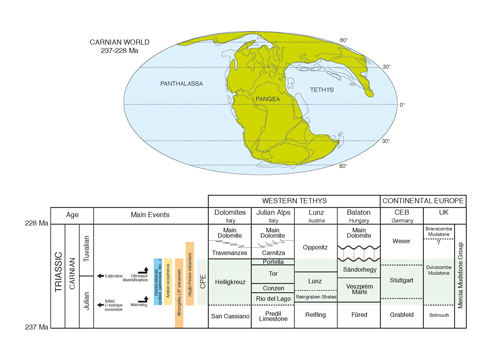
Fig. 1. Palaeogeography of the Triassic Carnian (upper) and correlation of the main events discussed with the marine and non-marine successions of Europe, where the primary evidence for this global climate change was first found. CPE (light green highlight) = Carnian Pluvial Episode; CEB = Central European Basins.
In 1989, Simms and Ruffell identified increased humidity during the Late Triassic as a pluvial episode, also known as the Carnian Pluvial Event and ‘Triassic Wet Intermezzo’. The latter term has a legacy dating back to 1973, when Schlager and Schollnberger named the shales that abruptly overlie Triassic reef limestones in the Alps as marking the ‘Reingraben Turnover’ (labelled as ‘CPE’ on Fig. 1). Later interpreted as reef drowning, it was the identification of coeval sandstones, such as the ‘Schilfsandstein’ of the Stuttgart Formation/Arden Sandstone of the North-West European and especially Germanic basins (Figs 2 and 3), fossil cave-fills in the Mendips of England and a biotic turnover, especially in marine organisms, that pointed to the idea of increased precipitation, which is the cornerstone of the current theory. Such change is now recognised in many Triassic successions throughout the Northern Hemisphere, as well as some in the Southern Hemisphere, but had at its core four locations: the Italian/Austrian Alps; the Dolomites; the Germanic/North Sea basins and southern England. Here we use evidence from these areas to document the historical and scientific progress of the humid theory.
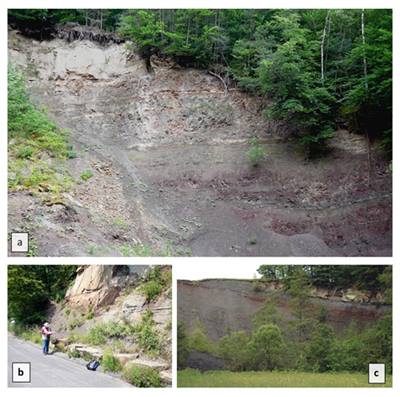 Fig. 2. The Schilfsandstein (Stuttgart Formation) in central southern Germany. a, Farnersberg (Naturpark Scwabisch-Frakischer Wald, near Heilbronn in 2006): abandoned clay pit with grey Schilfsandstein (incised) above grey and red Estheria beds (Grabfeld Formation), quarry face is appx. 30 m high. b, Iphofen (Naturpark Steigerwald, Wurzburg): road cut, grey Schilfsandstein (incised) above grey Estheria beds (Grabfeld Formation), Gerhard Bachmann for scale. c, Bodenmühle (Neumarkt in der Oberpfalz, SE of Nuremberg in 2006): natural outcrop, grey Schilfsandstein (incised) above grey and red Estheria beds (Grabfeld Formation). Images courtesy of Matthias Franz, Georg-August-Universität Göttingen.
Fig. 2. The Schilfsandstein (Stuttgart Formation) in central southern Germany. a, Farnersberg (Naturpark Scwabisch-Frakischer Wald, near Heilbronn in 2006): abandoned clay pit with grey Schilfsandstein (incised) above grey and red Estheria beds (Grabfeld Formation), quarry face is appx. 30 m high. b, Iphofen (Naturpark Steigerwald, Wurzburg): road cut, grey Schilfsandstein (incised) above grey Estheria beds (Grabfeld Formation), Gerhard Bachmann for scale. c, Bodenmühle (Neumarkt in der Oberpfalz, SE of Nuremberg in 2006): natural outcrop, grey Schilfsandstein (incised) above grey and red Estheria beds (Grabfeld Formation). Images courtesy of Matthias Franz, Georg-August-Universität Göttingen.
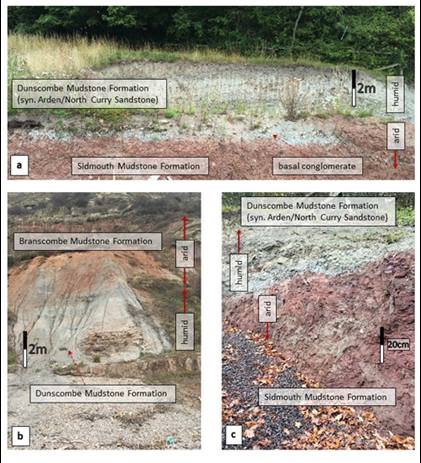
Fig. 3. The Arden Sandstone/Dunscombe Mudstone formation in south-west England. a, The lower part of the section at Lipe Hill, Taunton, Somerset, the location from which part of the original ‘pluvial’ theory originated. b, The type Dunscombe Mudstone Formation outcrop near Sidmouth, Devon, from which Miller et al. (2018) have defined separate humid intervals from C-isotopes and palynology. c, Incision of the grey/green Arden/Dunscombe (syn: North Curry Sandstone) into red/brown Sidmouth Mudstone, Sutton Mallet, Bridgwater, Somerset. Photo: Alastair Ruffell.
The climate change theory has had its critics, from those suggesting the Late Triassic rivers were isolated and not widespread, through to those sticking to the ‘turnover’ idea (regardless of its origin), to others suggesting eustatic control. In 2012, the discovery by Jacopo Dal Corso and colleagues of a global carbon-cycle perturbation at the onset of the climate change and its possible link to large igneous province (LIP) volcanism reinvigorated the debate. Interest in Carnian environmental and biotic change started to increase rapidly, and already the idea has generated over 50 publications since 1989, with most coming after 2012. A thematic edition of the Journal of the Geological Society of London is imminent and a study group dedicated to discussing Late Triassic changes meets annually at the Hanse-Wissenschaftkolleg, Institute for Advanced Study (Delmenhorst, Germany). Results from advanced sedimentary geochemical, chronological, sedimentological and palaeontological techniques are converging to indicate catastrophic changes at 232 Ma, driven by LIP eruptions such as Wrangellia (Alaska), as well as volcanic eruptions globally (such as the Huglu-Pnodos eruptions of Turkey and Greece; Fig. 1), triggering massive climatic and ecosystem upheaval worldwide, in the sea and on land
Palaeoclimatic Change
The CPE was not a single event, but instead lasted about 1.2 million years and was composed of four to six phases, according to analyses of black shales in the Italian Alps and carbon isotopes in the Mercia Mudstone Group (southern England).
Different lines of evidence point to a more humid climate during this 1.2-million-year episode: initial evidence came from the deposition of sometimes coarse siliciclastic bodies in generally fined-grained and evaporite-bearing continental and marginal marine environments; a broad, Nile-like river is thought to have flowed through the Keuper and Mercia landscape of what is now North-West Europe, while flash floods occurred in Iberia and north Africa; humid conditions are thought to have extended into the Panthalassic Ocean (now Japan); palaeosols that today typically develop in tropical humid environments have been found fossilised in the successions of the Southern Alps (Italy), Meseta (Spain), and Utah (USA); and semi-permanent, grey lake deposits replace ephemeral red-brown fluvial/lacustrine sediments in the Newark Basin (eastern USA and Canada) and humid soils developed in the south and central USA (current states of Utah and Arizona).
Other evidence comes fossil pollen and spores extracted from Carnian rocks. In 2004, Guido Roghi showed an increase of hygrophytic spores related to more humid climatic conditions during the Carnian in the Cave del Predil area of the Italian Julian Alps—findings confirmed by subsequent palynological studies from different geological settings throughout North-West Europe and beyond (such as Svalbard in Arctic Norway).
This idea of increased humidity influencing sedimentary changes and biotic evolution through the Triassic has become cemented in our understanding of Mesozoic palaeoenvironmental change and gained popular currency (as evidenced by 2 million views of the amusing PBS Eons YouTube presentation ‘The Chronicles of Carnia’). But, all was not green and lush in the Carnian world: evaporites and arid conditions persisted at times and in some areas. The CPE theory is centred on European successions, with some evidence for humid conditions appearing elsewhere (Fig. 1), it is currently unclear whether the CPE was truly global.
However, the observed increase in humidity was contemporaneous with a 4 to 7⁰C rise in sea-surface temperatures, as calculated from oxygen isotopes measured in conodont apatite, suggesting a Greenhouse Earth scenario for the CPE. This hypothesis is strongly supported by carbon-isotope geochemistry, which shows major negative shifts recorded in both terrestrial and marine organic carbon, and carbonate carbon during this time of increased humidity. Such a pattern indicates that large quantities of isotopically light carbon were transferred into the atmosphere, increasing pCO2 levels, causing global warming and enhancing the hydrological cycle. As for other similar episodes in Earth’s history (such as the end-Permian mass extinction and the eruption of the Siberian Traps), a synchronicity between the carbon-isotope disruption and the eruption of LIPs suggests a cause-and-effect relationship. Global warming can, of course, be triggered by mechanisms other than massive volcanism. For example, the Palaeocene-Eocene thermal maximum is often ascribed to oceanic methane release.
Carbonate Production
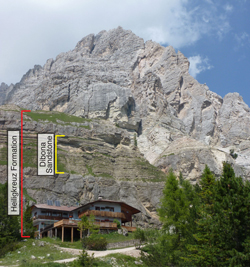 During the Carnian, a Tethys-wide change in carbonate production on platforms is observed in the successions of the European Alps, Himalayas and parts of China. The carbonate factory shifted from highly productive microbial producers to less productive metazoan ramps: often the early Carnian carbonate succession is overlain by shales seen as ‘platform drowning’ flooding surfaces (Fig. 4). This shift occurred at the same time as the negative carbon-isotope excursion during the onset of the humid episode. In Holocene tropical reefs, a decline of bacterial calcification over the past 12 thousand years has been linked to deglacial ocean acidification. This suggests that the CPE was also marked by brief ocean acidification, the “evil twin” of Anthropocene global warming.
During the Carnian, a Tethys-wide change in carbonate production on platforms is observed in the successions of the European Alps, Himalayas and parts of China. The carbonate factory shifted from highly productive microbial producers to less productive metazoan ramps: often the early Carnian carbonate succession is overlain by shales seen as ‘platform drowning’ flooding surfaces (Fig. 4). This shift occurred at the same time as the negative carbon-isotope excursion during the onset of the humid episode. In Holocene tropical reefs, a decline of bacterial calcification over the past 12 thousand years has been linked to deglacial ocean acidification. This suggests that the CPE was also marked by brief ocean acidification, the “evil twin” of Anthropocene global warming.
Fig. 4. Rifugio Dibona section (Tofane, Dolomites, Italy). Here the Heiligkreuz Formation contains “humid” palaeosols with abundant amber. Photo: Jacopo Dal Corso.
Biotic Extinctions and Radiations
Few studies have focused on marine extinction rates within the Triassic Period, yet the CPE appears to be associated with a major taxonomic turnover. In many different localities, the disappearance of about 70% of conodont genera and important early Carnian ammonoid groups (Trachyceratinae) is observed. In the late 1980s and early 1990s, Mike Simms linked evidence from the English (Somerset) and German sandstones for increased humidity during the Carnian to the demise of a group of crinoids, the encrinids, from which his remark came “perhaps the crinoids did not like the rain”. This may seem an implausible comment, but recently, a functional diversity study led by Alexander Dunhill of the University of Leeds showed that such suspension feeders decreased during the Carnian—probably because of the increased runoff and eutrophication of the sea water, confirming early evidence (Simms & Ruffell, 1989).
Extinction among other groups has not yet been systematically studied, but there is evidence that the climate change could have affected sponges, corals, Tubiphytes and bryozoans. The marine extinction was coupled to major evolutionary innovations that determined landmark changes in global ocean chemistry and the carbon cycle. Indications of the first calcareous nannoplankton date back to the Carnian. Recent work showed these first planktic calcifiers (Fig. 5) were probably calcareous dinoflagellates, which become abundant in the late Carnian, and formed a major component (10% of the total rock volume) of pelagic rocks. Paul Bown commented to us that true coccoliths (the main constituents of the Cretaceous White Cliffs of Dover), appeared soon after, in the Norian and Rhaetian. These first rock-forming calcareous nannoplankton marked a revolution in ocean chemistry and ecosystem structure.
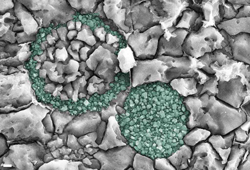
Fig. 5. Triassic calcispheres of probable dinoflagellate affinity (calcareous nannoplankton). Image courtesy of Nereo Preto. Scale bar is 10µm.
This was a change in global carbonate cycles that persists to the present day. The Carnian represents a period of transition from an ocean where carbonate precipitation was dominated by shallow water biocalcification to an ocean dominated by pelagic calcification—from a “Neritan” ocean to a “Cretan” ocean—with the deposition of kilometres of carbonate ooze on the ocean floor. Many workers term this ‘A Mid Mesozoic Revolution’, starting around the Triassic-Jurassic boundary: the rise of calcareous nannoplankton in the Carnian suggests that the preceding climate change was a major trigger. The evolution of the planktic calcifiers therefore created one of the key elements in the modern global carbon cycle. This acted to produce a much more efficient regulation of marine calcium carbonate saturation state, when reefs dominated by Tubiphytes of the early Triassic began giving way to those with scleractinian corals, more like our modern world.
Amber
The first “amber burst” in Earth history is synchronous with the CPE. Carnian amber is found in many localities around the world, the most famous being the amber from the Tofane Group in the Dolomites of northern Italy. Here, abundant amber drops that were probably produced by conifers (Fig. 6) are found embedded in palaeosols and contain important biological inclusions. Microscopic study of amber pieces from the Dolomites by Alexander Schmidt and colleagues at the University of Göttingen offers a unique possibility to look at the rich and diverse Carnian microworld: plant remains, bacteria, fungi, algae, and the oldest amber-preserved arthropods (mites) have been found.
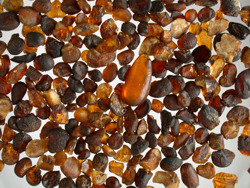
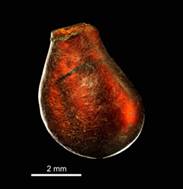 Fig. 6. Amber droplets a, From a palaeosol at the Rifugio Dibona (shown on Fig. 4). Each droplet measures a few millimetres. Field of view is 6cm. b, From the Dibona section (Dolomites, Italy). Images courtesy of Guido Roghi, Italian National Research Council.
Fig. 6. Amber droplets a, From a palaeosol at the Rifugio Dibona (shown on Fig. 4). Each droplet measures a few millimetres. Field of view is 6cm. b, From the Dibona section (Dolomites, Italy). Images courtesy of Guido Roghi, Italian National Research Council.
Studies on modern and past plant resins, recently summarized by Leyla Seyfullah and colleagues (in Biological Reviews), show that insect infestation, ecological disasters (such as hurricane or volcanic eruptions), fire and other stressors can trigger a significant increase in plant resin production. The ultimate reason for increased global amber production during the CPE must be found in the environmental changes of the time: increased seasonal humidity, wildfire activity, and the release of volcanic gases like SO2 into the atmosphere could have contributed to stress the flora on a global scale.
Diversification of the Dinosaurs
The origin of the dinosaurs is long-debated. What is agreed is that the Triassic began as a dinosaur-free world and ended with dinosaurs everywhere. The original ideas (from about 1980) were that the Dinosauria arose either through a long process of competitive replacement during the Triassic, or that they had more or less exploded onto the scene during the Carnian following an extinction event. There is a bit of truth in both models.
In 1980, the oldest dinosaurs were known from the late Carnian Ischigualasto Formation of Argentina, and age-equivalent rocks in Brazil, India, and the United States. However, it is now agreed that the first dinosaurs trod this Earth at the end of the Early Triassic, 245 Ma. The evidence is tenuous, but multiple: footprints from Poland, a possible early dinosaur from Tanzania, and a definite close sister group dinosauromorph, also from Tanzania.
So, it seems that dinosaurs originated in the Early Triassic (Fig. 7), when so many new groups tentatively emerged during the maelstrom of climate shocks and repeatedly rebuilt ecosystems during recovery from the devastating Permian-Triassic mass extinction. But dinosaurids remained at very low diversity and abundance—almost undetectable—until the mid and late Carnian. The CPE seems to have caused major floral change in Gondwana, with the previously abundant seed ferns being replaced by conifers, which were adapted to the new post-crisis return to arid climates. With the extinction of the seed ferns went the rhynchosaurs—the previously dominant herbivores, squat, pig-shaped animals that may represent up to 80% of tetrapod faunas and have been found from Scotland to Argentina, and from India to Tanzania.
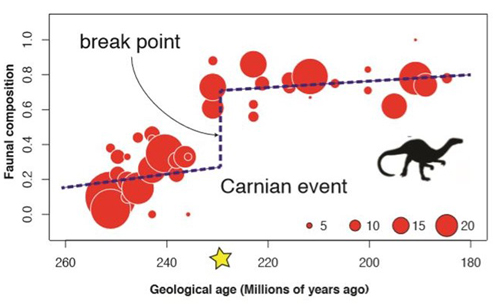
Fig. 7. The composition of tetrapod faunas appears to break at ~232 million years ago. Each red bubble represents a separate well-preserved fauna, consisting of 5 to 30 genera (bubble size scales faunal size). The y-axis is the ratio of dinosaurs and close relatives to all tetrapods, and the value jumps from an average of about 0.2 to 0.75, marking a change in ecology. The dashed line is used to demonstrate a change rather than correlate data points. We used a break point numerical analysis that seeks to fit two lines, with a break at an arbitrary point to best explain the data. The approach reveals a break point during the Carnian. However, the data could also be fit by a curve, suggesting the transition was more gradual. Based on data in Benton et al. (2018).
The dinosaurs did not take over immediately. Most of the late Carnian forms were still small carnivores, but some, such as Herrerasaurus from the Ischigualasto Formation of Argentina, had become larger, at up to 6 m long. Herrerasaurus was a powerful, bipedal beast, capable of preying on all animals of its day. There were also plant-eating sauropodomorphs such as Saturnalia and Panphagia in South America, but these were only 1.5 metres long and quite rare. Dinosaurian herbivores came into their own during the subsequent, long Norian stage, with giants such as the 5 to 10-m-long Plateosaurus found preserved in Germany and Riojasaurus in Argentina.
Side-by-side with the new dinosaurs were many other tetrapod groups that would seem familiar today—the first turtles, crocodiles, lizards, and mammals. Admittedly, all of these were rare, but it is intriguing that we can trace most modern land vertebrates to this time of climatic and floral upheaval in the Late Triassic.
After the Carnian episode, marine limestone-dominated and non/quasi-marine ‘Keuper’ or ‘Mercia’ style deposition returned (albeit with different biota). This is strange because most revolutions in Earth history show continued changes thereafter, yet it seems the late Triassic mainly returned to how it was. Maybe Pangaea and the Tethyan/Panthalassic oceans were just too vast to allow anything else.
Alastair Ruffell1*; Jacopo Dal Corso2; Mike Benton3
1. Queen’s University Belfast, School of the Natural Built Environment, Belfast, BT7 1NN, Northern Ireland.
2. University of Leeds, School of Earth and the Environment, Leeds, LS2 9JT, UK.
3. University of Bristol, School of Earth Sciences, Bristol, BS8 1TH, UK.
* [email protected]
FURTHER READING
Benton, M.J. 1983. Dinosaur success in the Triassic: a noncompetitive ecological model. Quarterly Review of Biology 58, 29-55.
Benton, M.J. 1986. More than one event in the late Triassic mass extinction. Nature 321, 857-861.
Benton, M.J. et al. 2014. Models for the rise of the dinosaurs. Current Biology 24, R87-R95.
Benton, M.J. et al. 2018. The Carnian Pluvial Episode and the origin of the dinosaurs. Journal of the Geological Society, in press.
Bernardi, M. et al. 2018. Dinosaur diversification linked with the Carnian Pluvial Episode. Nature Communications 9, 1499.
Dal Corso, J. et al. 2012. Discovery of a major negative δ13C spike in the Carnian (Late Triassic) linked to the eruption of Wrangellia flood basalts. Geology 40, 79-82.
Dal Corso, J. et al. 2015. Carbon isotope records reveal synchronicity between carbon cycle perturbation and the “Carnian Pluvial Event” in the Tethys realm (Late Triassic). Global & Planetary Change 127, 79-90.
Dal Corso, J. et al. 2018. First Workshop on the Carnian Pluvial Episode (CPE): a report. Albertiana, 44, 49-57.
Dal Corso, J. et al. 2018. Multiple negative carbon-isotope excursions during the Carnian Pluvial Episode (Late Triassic). Earth Science Reviews, in press.
Miller, C. et al. 2017. Astronomical age constraints and extinction mechanisms of the late Triassic Carnian crisis. Scientific Reports 7, 2557.
Seyfullah, L.J. et al. 2018. Production and preservation of resin – past and present. Biological Reviews, in press.
Simms, M. & Ruffell, A. 1989. Synchroneity of climatic change and extinctions in the Late Triassic. Geology 17, 265-268.
PBS Eons video ‘The Chronicles of Carnia’ https://www.youtube.com/watch?v=_1LdMWlNYS4